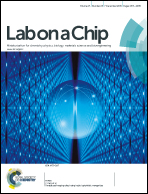Swallowable fluorometric capsule for wireless triage of gastrointestinal bleeding†
Abstract
Real-time detection of gastrointestinal bleeding remains a major challenge because there does not yet exist a minimally invasive technology that can both i) monitor for blood from an active hemorrhage and ii) uniquely distinguish it from blood left over from an inactive hemorrhage. Such a device would be an important tool for clinical triage. One promising solution, which we have proposed previously, is to inject a fluorescent dye into the blood stream and to use it as a distinctive marker of active bleeding by monitoring leakage into the gastrointestinal tract with a wireless fluorometer. This paper reports, for the first time to our knowledge, the development of a swallowable, wireless capsule with a built-in fluorometer capable of detecting fluorescein in blood, and intended for monitoring gastrointestinal bleeding in the stomach. The embedded, compact fluorometer uses pinholes to define a microliter sensing volume and to eliminate bulky optical components. The proof-of-concept capsule integrates optics, low-noise analog sensing electronics, a microcontroller, battery, and low power Zigbee radio, all into a cylindrical package measuring 11 mm × 27 mm and weighing 10 g. Bench-top experiments demonstrate wireless fluorometry with a limit-of-detection of 20 nM aqueous fluorescein. This device represents a major step towards a technology that would enable simple, rapid detection of active gastrointestinal bleeding, a capability that would save precious time and resources and, ultimately, reduce complications in patients.


 Please wait while we load your content...
Please wait while we load your content...